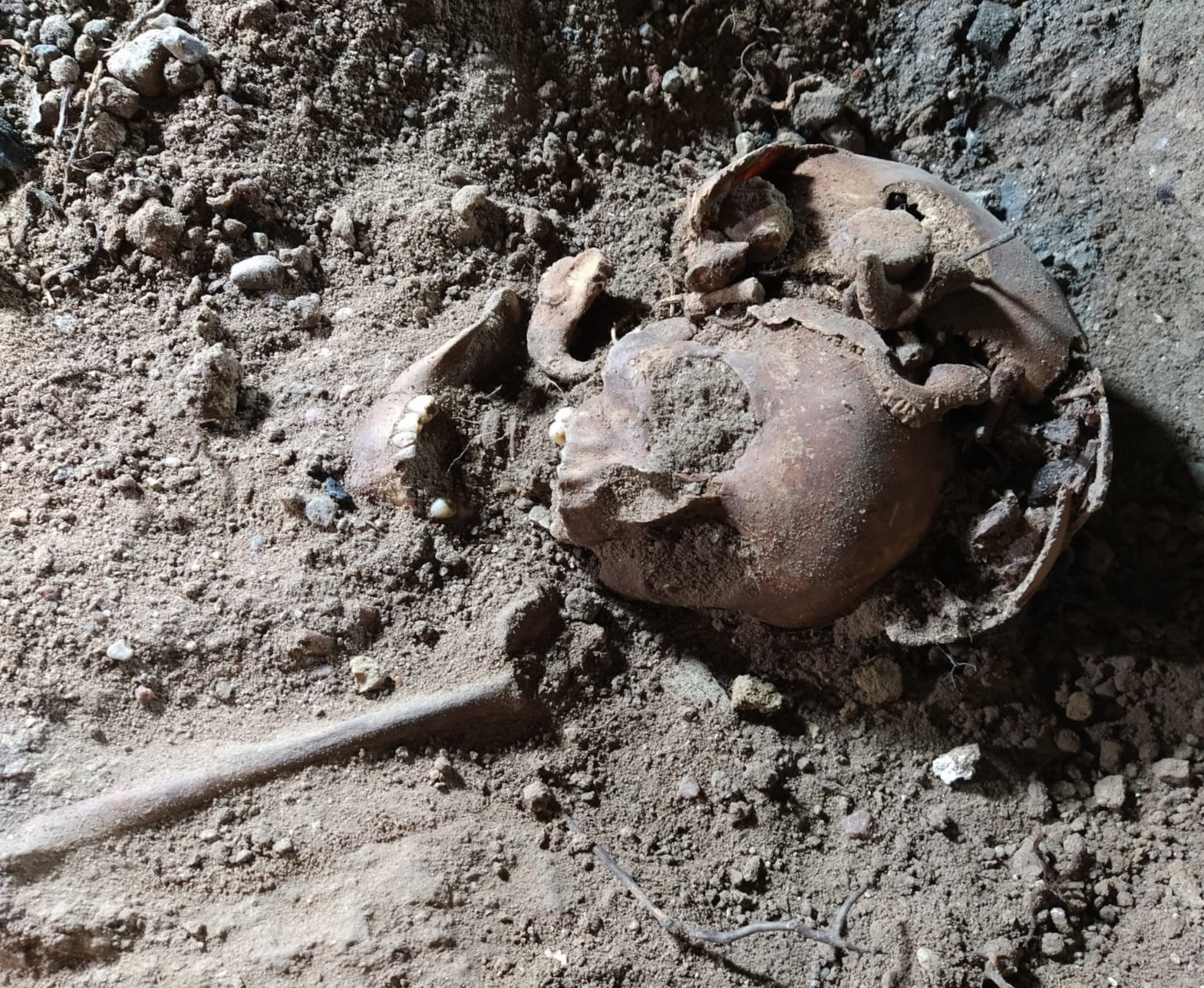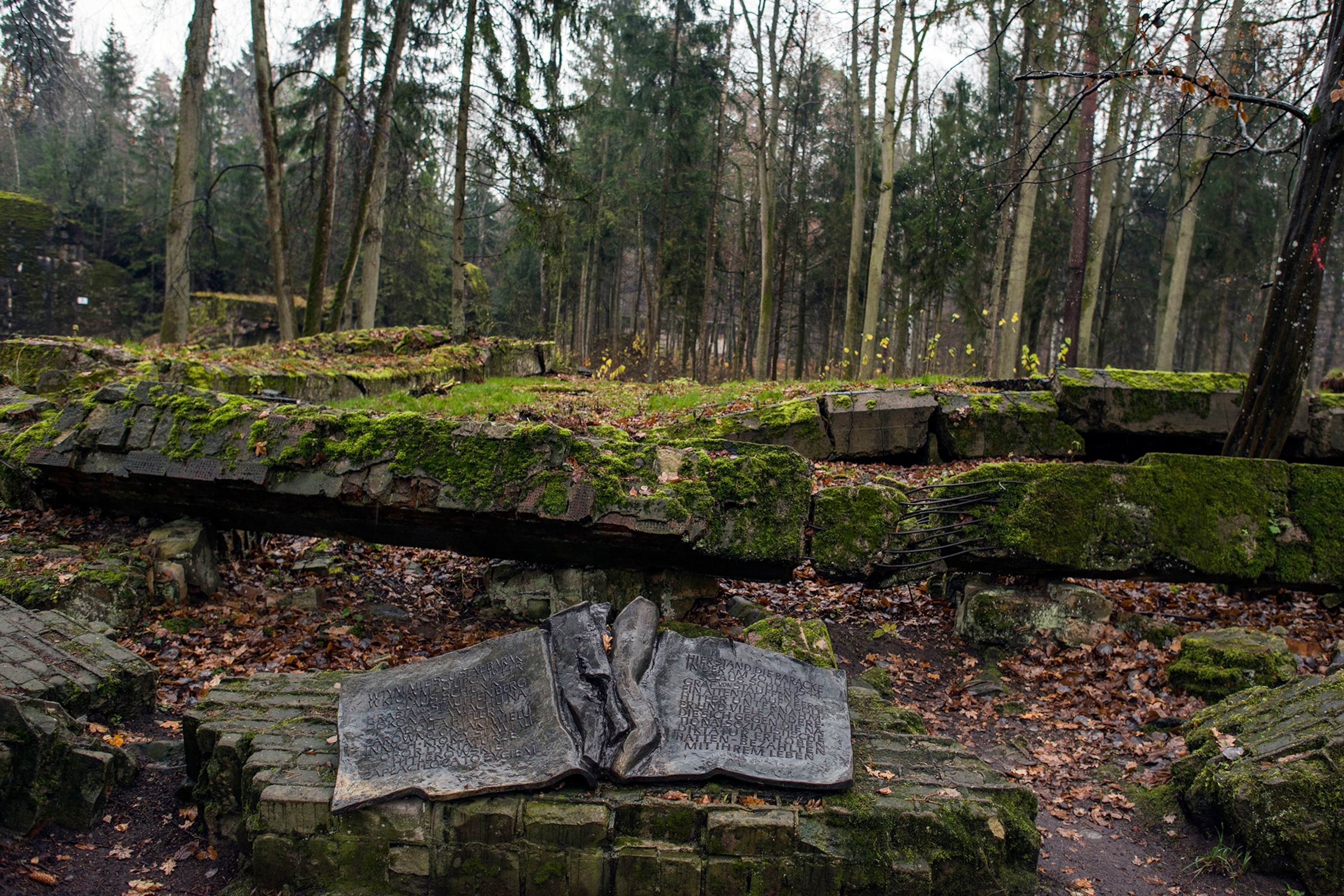What lies beneath Hitler's war lair? Explorers just found out.
Researchers are trying to determine the fate of the five people—all missing their hands and feet—buried in Hermann Göring’s residence at Hitler’s top-secret military quarters.

Amateur archaeologists in Poland recently unearthed five human skeletons—each missing hands or feet—from beneath a house once occupied by Hermann Göring. The Nazi field marshal was second-in-command, after Adolf Hitler, of the Third Reich.
The macabre discovery was made in late February at the Wolf’s Lair, or Wolfsschanze, near the town of Kętrzyn in northeast Poland; in 1940 Hitler ordered a secret military headquarters built at the remote spot to prepare for his invasion of the Soviet Union.
While the remains have not yet been conclusively dated, the burials appear to be those from a family who fell victim to the tumultuous history of the region in the early 20-century.
Into the Wolf’s Lair
Gdansk engineer Adrian Kostrzewa, the member of Poland’s Latebra Foundation who discovered the first skeleton, says his volunteer group was working over a winter weekend to recover any artifacts, such as nails or building materials, from the ruins of Göring’s house at the site, which still stands near what’s left of Hitler’s bunker.
Members of the Latebra Foundation have worked at the Wolf’s Lair site—now in a state forest park—for more than five years, authorized by the site’s management and government officials.
Kostrzewa says he was excavating beneath what was once the floor of the Göring’s house when he found what he thought was a plumbing pipe, but which turned out to be a human skull.
After the first discovery, the excavation team called the police, who unearthed the skeletons of four more people—including a teenager and a newborn baby—all buried in a line.
It’s not clear why they were buried there, but a police investigation has now determined from their obvious age that the skeletons are probably from before 1945, Kostrzewa says. The police have now concluded their investigation, which means the group can now talk about the finds, he adds.

A difficult history
The Latebra Foundation has existed for 30 years and specializes in unearthing archaeological artifacts from different periods in Poland’s storied and difficult history, often by using metal detectors—an activity that requires permits in the country. According to the group’s website, all their work is legal, carried out with consent, and usually published for transparency.
The Wolf’s Lair is fenced off from treasure hunters, and the Latebra Foundation has exclusive access; everything it recovers is displayed in the site’s museum, Kostrzewa says.
The group’s videos on YouTube show it has mainly recovered small items—uniform buttons, tools, and machine parts, for example—which Kostrzewa says can help “uncover the truth about what happened in this place."
But the 30 volunteers of the Latebra Foundation had never seen anything like these skeletons before, he says: “It’s a sad story.”
Operation Barbarossa
Hitler and many other Nazi leaders, including Göring —the commander of the Luftwaffe, and ostensibly Hitler’s successor—spent many months at the Wolf’s Lair between 1941 and 1944.
But despite his middle-class background, Göring styled himself as a Prussian aristocrat, and his lavish lifestyle included the acquisition of several homes, including his sprawling Carinhall estate near Berlin. As a result, his stays at his residence in the Wolf’s Lair were probably limited to essential meetings.
The complex of about 200 buildings—including bunkers, shelters, barracks, a power plant and a railway station—was staffed by more than 2,000 people at its peak, when it served as the Nazi headquarters for Operation Barbarossa—the German invasion of the Soviet Union.
The Wolf’s Lair was partially destroyed by the retreating Nazis and largely ignored during the Cold War years; it opened for tourism after the fall of Communism in Poland in the 1990s.
Today the site attracts tens of thousands of tourists a month; and it recently underwent a makeover to reconstruct the conference room where the German army office Claus von Stauffenberg detonated a suitcase bomb in an attempt to kill Hitler in 1944. The blast killed four people and injured twenty more; but Hitler, who was shielded by a leg of the conference room table, emerged almost unscathed.

Investigation closed?
The skeletons were buried in the floor just a few inches below the surface and right next to 1940s-era plumbing pipes for the house, meaning that if they were indeed buried before Göring moved in, construction workers would have found the remains—and must have left them where they were.
Among the other peculiarities of the burials is that no evidence of clothing was found (although it may have rotted away with time), and each of the skeletons is missing its hands and feet, except one with a few toes. Some archaeologists have suggested the hands and feet may have decayed before the rest of the bodies. But just why all five bodies would be found in such an odd manner has not been explained: “It’s creepy,” Kostrzewa concedes.
Rafał Jackowski, a spokesperson for the Warmian-Masurian Provincial Police in charge of the area, says the discoveries at the Wolf’s Lair were investigated by officers and a medical examiner from Kętrzyn. According to the medical examiner, the skeletons appear from their age to be from the “interwar” years between 1918 and 1939, and the poor condition of the remains means it is now impossible to determine the causes of their deaths.
As a result, the police have no reason to think that a crime has been committed and have closed their investigation.
Dating the bones
The next step will be for the Latebra Foundation to sample the remains and send them radiocarbon dating, which could establish to within a few years just when the people died. The foundation will also undertake other methods try to determine who the people were. Until then, the many theories about why they were buried beneath Hermann Göring’s house at the Wolf’s Lair can only be speculation.
Some newspapers have speculated that the skeletons beneath Göring’s house were the result of human sacrifices. Some leading Nazis, especially SS head Heinrich Himmler, indulged in what they thought were German pagan religious beliefs.
An unknown number of dart-shaped stones called belemnites were found near the bodies during the police investigations, according to Kostrzewa. Since ancient Greek times, the distinctive stones were believed to be created by lightning striking the ground and were sometimes placed in pagan burials as good-luck charms. But belemnites—actually the fossilized remains of prehistoric squid—also occur naturally in the region. Kostrzewa adds there is no other evidence of paganism or any other sort of ritual practices.
For his part, however, Kostrzewa thinks the five skeletons were all from members of a single family—as well as the newborn, there is evidence that another victim was very elderly when they died. “That’s the most probable idea,” Kostrzewa says. “Rather less probable is that someone made a building right over an old cemetery.”
Polish war historian Paweł Machcewicz of the Polish National Academy’s Institute of Political Studies, who wasn’t involved in the discoveries, suggests the remains might be from laborers forced to build the Wolf’s Lair complex, but that idea doesn’t explain the presence of a newborn in the burials.
Machcewicz also speculates they could be from people killed by the Red Army after it overran the Wolf’s Lair in 1944, when Soviet soldiers committed terrible atrocities on civilians; or that the people had been victims of violence after World War II.
Historian Robert Traba, an expert on the region also with the Institute of Political Studies and who also wasn’t involved, adds that little professional research has been carried out at the Wolf’s Lair site, and so it is unsurprising that there are still discoveries there.
The skeletons add further mystery to the story of the Wolf’s Lair, Traba says: “The Wolfsschanze hides many puzzles and problems.”
Related Topics
You May Also Like
Go Further
Animals
- California brown pelicans are starving to death—despite plenty to eatCalifornia brown pelicans are starving to death—despite plenty to eat
- The world's largest fish are vanishing without a traceThe world's largest fish are vanishing without a trace
- We finally know how cockroaches conquered the worldWe finally know how cockroaches conquered the world
- Why America's 4,000 native bees need their day in the sunWhy America's 4,000 native bees need their day in the sun
- Crowdsourcing an anti-poaching movement in South Africa
- Paid Content
Crowdsourcing an anti-poaching movement in South Africa
Environment
- 2024 hurricane season forecasted to be record-breaking year2024 hurricane season forecasted to be record-breaking year
- Connecting a new generation with South Africa’s iconic species
- Paid Content
Connecting a new generation with South Africa’s iconic species - These images will help you see coral reefs in a whole new wayThese images will help you see coral reefs in a whole new way
- What rising temps in the Gulf of Maine mean for wildlifeWhat rising temps in the Gulf of Maine mean for wildlife
- He’s called ‘omacha,’ a dolphin that transforms into a man. Why?He’s called ‘omacha,’ a dolphin that transforms into a man. Why?
History & Culture
- I wrote this article with a 18th century quill. I recommend it.I wrote this article with a 18th century quill. I recommend it.
- Why this Bronze Age village became known as ‘Britain’s Pompeii’Why this Bronze Age village became known as ‘Britain’s Pompeii’
- These modern soldiers put Bronze Age armor to the testThese modern soldiers put Bronze Age armor to the test
- Should couples normalize sleeping in separate beds?Should couples normalize sleeping in separate beds?
- They were rock stars of paleontology—and their feud was legendaryThey were rock stars of paleontology—and their feud was legendary
Science
- Epidurals may do more than relieve pain—they could save livesEpidurals may do more than relieve pain—they could save lives
- Why the world's oldest sport is still one of the best exercisesWhy the world's oldest sport is still one of the best exercises
- What if aliens exist—but they're just hiding from us?What if aliens exist—but they're just hiding from us?
Travel
- This less crowded ancient temple in Laos rivals Angkor WatThis less crowded ancient temple in Laos rivals Angkor Wat
- Visit Rotterdam as it transforms itself into a floating cityVisit Rotterdam as it transforms itself into a floating city
- How to get off the beaten track in Northern LanzaroteHow to get off the beaten track in Northern Lanzarote







